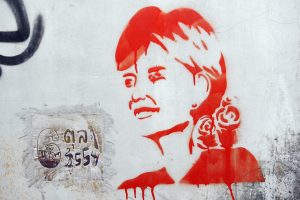On a sweltering day marking the end of Thingyan, the Burmese New Year, a media outlet in Yangon published a weather-related scoop.
Eleven Media Group revealed that Aung San Suu Kyi had been moved out of her quarters in Naypyidaw prison due to “extreme heat.” On April 16, the day of her transfer, the temperature in Myanmar’s capital reached a maximum of 40 degrees Celsius (104 degrees Fahrenheit).
Myanmar’s military confirmed the report but did not provide details on the ousted leader’s new location. A spokesperson said “necessary precautions” had been taken for older prisoners, including former President Win Myint, who may have moved into a house with air conditioning.
Unidentified sources told the Singapore-based news channel CNA that Aung San Suu Kyi was moved from the “cell” where she was incarcerated but had not left the prison complex.
The imprisoned leader’s son reacted to news of her transfer to “house arrest” with skepticism. London-based Kim Aris told CNN his mother is “either still in prison or she’s in the residence of a military official” but was not at her Yangon house. He speculated that her relocation was a tactical move rather than a humanitarian gesture. Aris believes military leaders might use his mother as a “bargaining chip” if the fighting moved closer to Naypyidaw.
Myanmar’s army suffered a severe setback in April when an alliance of regional militias operating near the border with Thailand seized an infantry outpost. The Karen National Union (KNU) announced that its armed wing had taken control of Myawaddy, a river town that serves as the primary conduit for more than $1 billion in trade between the two countries.
Aung San Suu Kyi’s relocation took place a few days after the border debacle although it’s not clear if the two events were directly connected.
In an interview with Reuters, Thailand’s Prime Minister Srettha Thavisin said Myanmar’s military regime was “starting to lose some strength” and might be open to negotiations. But Bangkok may have been blindsided by shifting loyalties on the ground. Myanmar’s military recaptured Myawaddy on April 24 after a local Karen militia leader abruptly switched sides.
Some media outlets speculated that Beijing may have lobbied for Aung San Suu Kyi’s move. Deng Xijun, China’s Special Envoy for Asian Affairs, visited Naypyidaw in early April to discuss “peace and stability.” Border irritants such as online scam centers, narcotics smuggling, and ethnic militia skirmishes were on the agenda. In January, China protested when a stray artillery shell fired from the Kokang region in northern Myanmar landed in Yunnan, injuring five people.
China wants the border to be “as stable as possible,” said Digby James Wren, an international relations scholar at the Royal Academy of Cambodia. He ventured that Beijing may be scaling back its support to Myanmar’s military. Junta leader Senior Gen. Min Aung Hlaing has yet to receive an invitation to visit China. By contrast, Aung San Suu Kyi met Xi Jinping multiple times when she was in office.
Despite mediation efforts by neighbors and regional blocs like the Association of Southeast Asian Nations (ASEAN), negotiations with Naypyidaw have stalled.
Myanmar remains deeply fractured. The military controls the center of the country. But the periphery is a “kaleidoscopic array of competing influences” made up of ethnic armies, pro-democracy activists, and narcotics traffickers, among others. Saw Chit Thu, the militia leader who switched sides and now appears to control Myawaddy, runs a “sprawling business enterprise” with ties to online scam centers.
In late April, “extreme heat” was back in the news. The town of Chauk, around 190 kilometers from Naypyidaw, was briefly the hottest place in Asia with temperatures rising to 48.2 degrees Celsius (118.8 degrees Fahrenheit).
Aung San Suu Kyi appears to have escaped the tin-roofed cinder-block structure in Naypyidaw prison for now. Sean Turnell, her former economic policy advisor who was incarcerated in the same facility, described the summers there as “off-the-dial awful.” He told Nikkei Asia in February that the 78-year-old Nobel laureate was offered air conditioning but declined, saying she did not want special treatment.

































